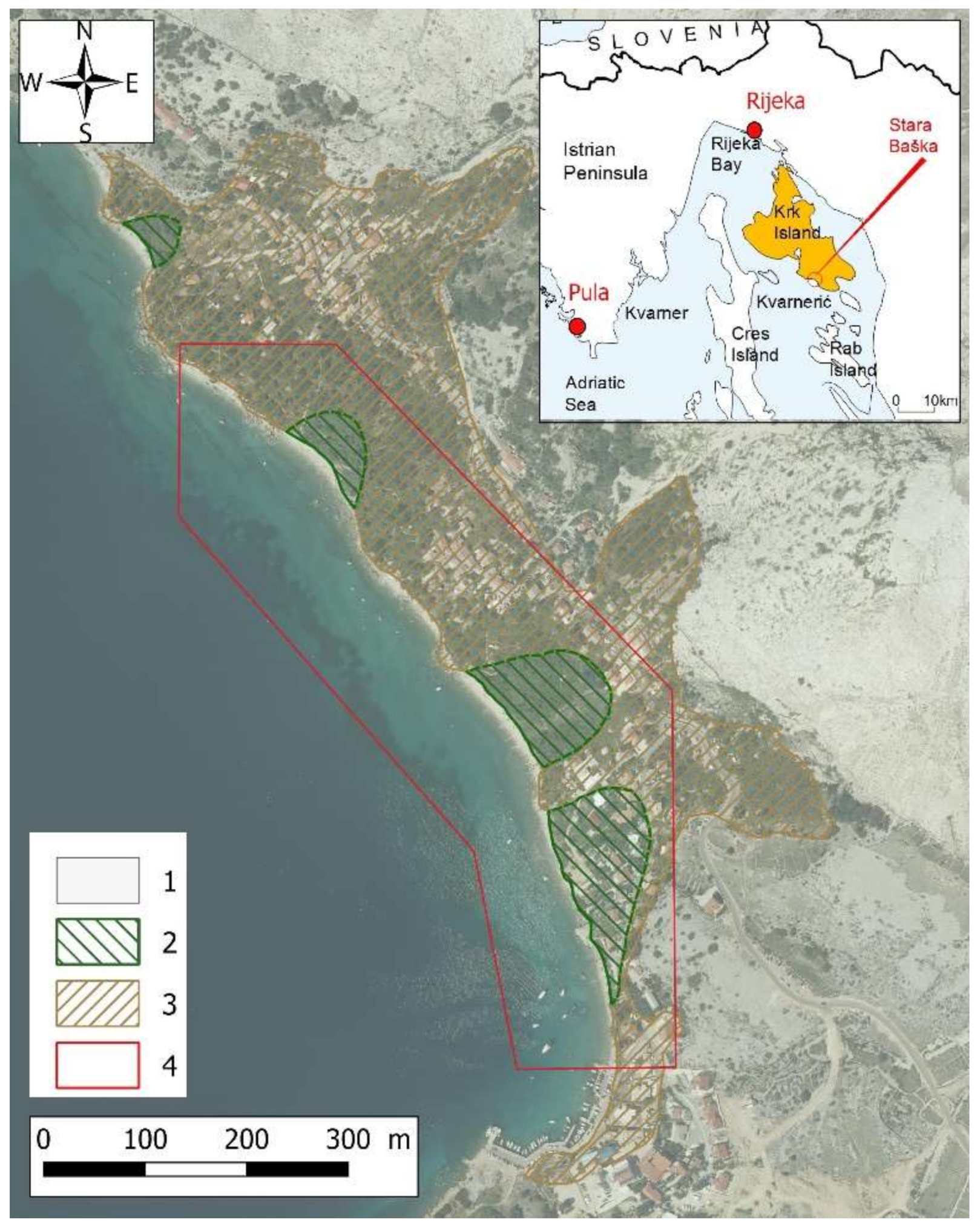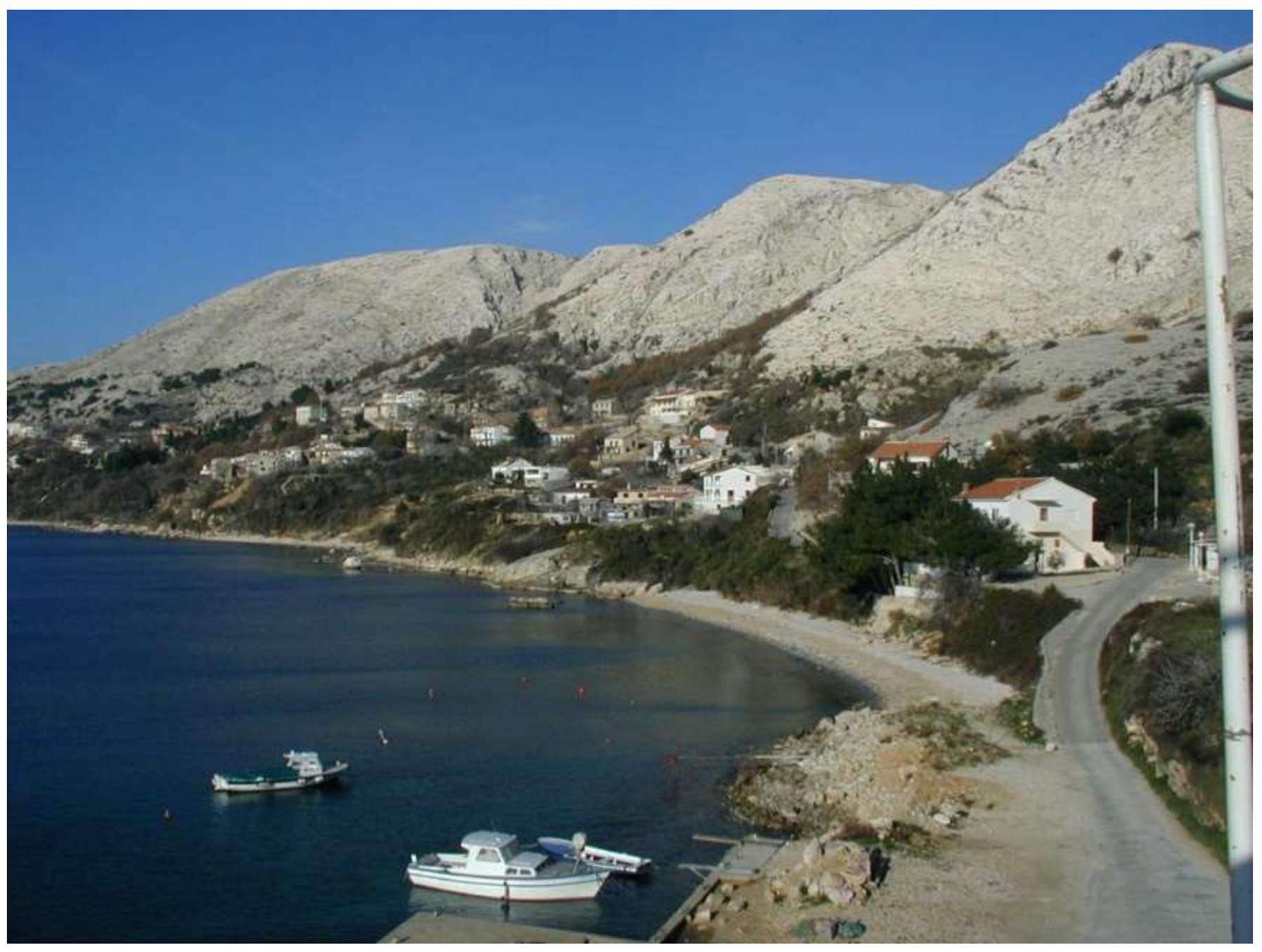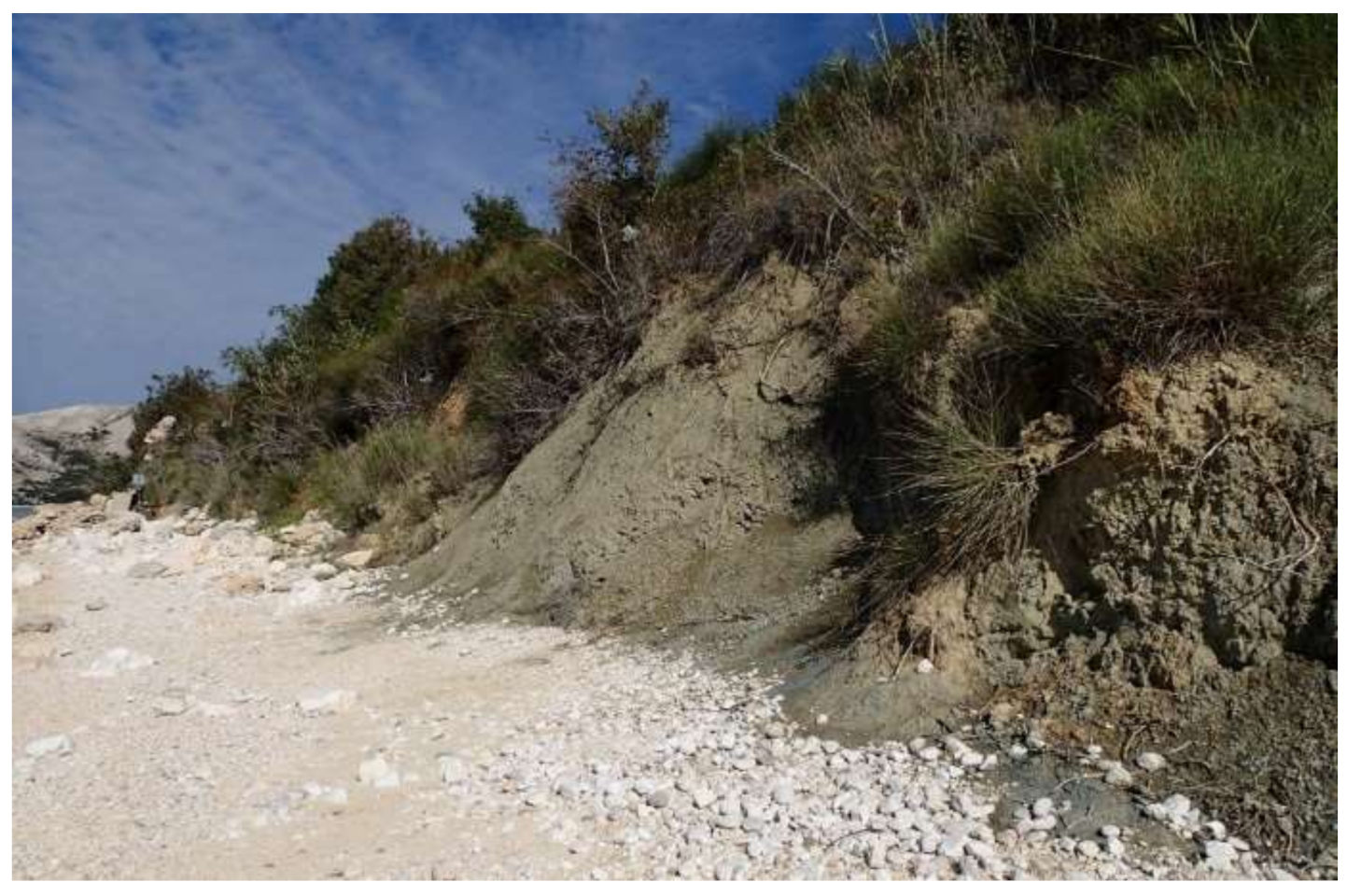The Application of UAV for the Analysis of Geological Hazard in Krk Island, Croatia, Mediterranean Sea
Abstract
1. Introduction
2. Study Area
2.1. Geological Structure
2.2. Hydrological and Hydrogeological Conditions
2.3. Oceanographical Conditions
3. Methodology
4. Results and Discussion
5. Conclusions
Author Contributions
Funding
Acknowledgments
Conflicts of Interest
References
- ETC CCA. Methods for Assessing Coastal Vulnerability to Climate Change; ETC CCA Technical Paper 1/2011; ETC CCA: Bologna, Italy, 2011. [Google Scholar]
- De Pippo, T.; Donadio, C.; Pennetta, M.; Petrosino, C.; Terlizzi, F.; Valente, A. Coastal hazard assessment and mapping in Northern Campania, Italy. Geomorphology 2008, 97, 451–466. [Google Scholar] [CrossRef]
- Sánchez-Arcilla, A.; Mösso, C.; Sierra, J.P.; Mestres, M.; Harzallah, A.; Senouci, M.; Raey, M. El Climatic drivers of potential hazards in Mediterranean coasts. Reg. Environ. Chang. 2011, 11, 617–636. [Google Scholar] [CrossRef]
- Richards, J.A.; Nicholls, R.J. Impacts of Climate Change in Coastal Systems in Europe. PESETA-Coastal Systems Study; European Commission: Seville, Spain, 2009. [Google Scholar]
- Adams, P.N.; Storlazzi, C.D.; Anderson, R.S. Nearshore wave-induced cyclical flexing of sea cliffs. J. Geophys. Res. Earth Surf. 2005, 110. [Google Scholar] [CrossRef]
- Ruggiero, P.; Komar, P.D.; McDougal, W.G.; Marra, J.J.; Beach, R.A. Wave runup, extreme water levels and the erosion of properties backing beaches. J. Coast. Res. 2001, 17, 407–419. [Google Scholar]
- Sallenger, A.H.; Krabill, W.; Brock, J.; Swift, R.; Manizade, S.; Stockdon, H. Sea-cliff erosion as a function of beach changes and extreme wave runup during the 1997–1998 El Niño. Mar. Geol. 2002, 187, 279–297. [Google Scholar] [CrossRef]
- Dornbusch, U.; Robinson, D.A.; Moses, C.A.; Williams, R.B.G. Temporal and spatial variations of chalk cliff retreat in East Sussex, 1873 to 2001. Mar. Geol. 2008, 249, 271–282. [Google Scholar] [CrossRef]
- Emery, K.O.; Kuhn, G.G. Sea cliffs: Their processes, profiles, and classification. Geol. Soc. Am. Bull. 1982, 93, 644–654. [Google Scholar] [CrossRef]
- Collins, B.D.; Sitar, N. Processes of coastal bluff erosion in weakly lithified sands, Pacifica, California, USA. Geomorphology 2008, 97, 483–501. [Google Scholar] [CrossRef]
- Komar, P.D.; Shih, S.M. Cliff erosion along the Oregon coast: A tectonic-sea level imprint plus local controls by beach processes. J. Coast. Res. 1993, 9, 747–765. [Google Scholar]
- Hutchinson, J.N. A reconsideration of the coastal landslides at folkestone warren, kent. Geotechnique 1969, 19, 6–38. [Google Scholar] [CrossRef]
- Dietze, M.; Cook, K.L.; Illien, L.; Rach, O.; Puffpaff, S.; Stodian, I.; Hovius, N. Impact of Nested Moisture Cycles on Coastal Chalk Cliff Failure Revealed by Multiseasonal Seismic and Topographic Surveys. J. Geophys. Res. Earth Surf. 2020, 125, e2019JF005487. [Google Scholar] [CrossRef]
- Sunamura, T. Rock control in coastal geomorphic processes. Int. J. Rock Mech. Min. Sci. Geomech. Abstr. 1995, 32, 103A. [Google Scholar]
- Greenwood, R.O.; Orford, J.D. Factors controlling the retreat of drumlin coastal cliffs in a low energy marine environment—Strangford Lough, Northern Ireland. J. Coast. Res. 2007, 232, 285–297. [Google Scholar] [CrossRef]
- Lee, E.M. Coastal cliff behaviour: Observations on the relationship between beach levels and recession rates. Geomorphology 2008, 101, 558–571. [Google Scholar] [CrossRef]
- Sunamura, T. Projection of future coastal cliff recession under sea level rise induced by the greenhouse effect: Nii-jima Island, Japan. Trans. Jpn. Geomorphol. Union 1988, 9, 17–33. [Google Scholar]
- Dickson, M.E.; Walkden, M.J.A.; Hall, J.W. Systemic impacts of climate change on an eroding coastal region over the twenty-first century. Clim. Chang. 2007, 84, 141–166. [Google Scholar] [CrossRef]
- Bray, M.J.; Hooke, J.M. Prediction of soft-cliff retreat with accelerating sea-level rise. J. Coast. Res. 1997, 13, 453–467. [Google Scholar]
- Lee, K.H.; Mizutani, N.; Hur, D.S.; Kamiya, A. The effect of groundwater on topographic changes in a gravel beach. Ocean Eng. 2007, 34, 605–615. [Google Scholar] [CrossRef]
- Ružić, I.; Dugonjić, S.; Benac, Č.; Krvavica, N. Assessment of the Coastal Vulnerability Index in an Area of Complex Geological Conditions on the Krk Island, Northeast Adriatic Sea. Geosciences 2019, 9, 219. [Google Scholar] [CrossRef]
- Pikelj, K.; Ružić, I.; Ilić, S.; James, M.R.M.R.; Kordić, B. Implementing an efficient beach erosion monitoring system for coastal management in Croatia. Ocean Coast. Manag. 2018, 156, 223–238. [Google Scholar] [CrossRef]
- Benac, Č.; Ružić, I.; Žic, E. Ranjivost obala u području Kvarnera. Pomor. Zb. 2007, 44, 201–214. [Google Scholar]
- Juračić, M.; Benac, Č.; Pikelj, K.; Ilić, S. Comparison of the vulnerability of limestone (karst) and siliciclastic coasts (example from the Kvarner area, NE Adriatic, Croatia). Geomorphology 2009, 107, 90–99. [Google Scholar] [CrossRef]
- Benac, Č.; Jovančević Dugonjić, S.; Ružić, I.; Vivoda, M.; Peranic, J. Marine erosion and slope movements: SE coast of the Krk island. In Landslide Science for a Safer Geoenvironment: Volume 3: Targeted Landslides; Springer: Berlin/Heidelberg, Germany, 2014; pp. 563–567. [Google Scholar]
- Ružić, I.; Marović, I.; Benac, Č.; Ilić, S. Coastal cliff geometry derived from structure-from-motion photogrammetry at Stara Baška, Krk Island, Croatia. Geo-Mar. Lett. 2014, 34, 555–565. [Google Scholar] [CrossRef]
- Ružić, I.; Benac, Č. Vulnerability of the rab island coastline due to sea level rise. Hrvat. Vode 2016, 24, 203–214. [Google Scholar]
- Ružić, I.; Benac, Č.; Ilić, S.; Krvavica, N.; Rubinić, J. Geomorphological changes in a miniature beach in the karst. Hrvat. Vode 2018, 26, 27–34. [Google Scholar]
- Benac, Č. Recentni geomorfološki procesi i oblici u području Riječkog zaljeva. Croat. Geogr. Bull. 1992, 54, 1–18. [Google Scholar]
- Pikelj, K.; Juračić, M. Eastern Adriatic Coast (EAC): Geomorphology and Coastal Vulnerability of a Karstic Coast. J. Coast. Res. 2013, 29, 944–957. [Google Scholar] [CrossRef]
- Lončar, G.; Carević, D.; Paladin, M. Analysis of wave deformations before Zagrebačka obala—Port of Rijeka. Hrvat. Vode 2014, 22, 327–336. [Google Scholar]
- Faculty of Civil Engineering, University of Rijeka. Analysis of the Coastal Zone Vulnerability of the Primorje-Gorski Kotar County Due to Sea Level Rise; Faculty of Civil Engineering, University of Rijeka: Rijeka, Croatia, 2020. [Google Scholar]
- Ružić, I.; Benac, Č.; Marović, I.; Ilić, S. A stability assessment of coastal cliffs using digital imagery. Acta Geotech. Slov. 2015, 12, 25–35. [Google Scholar]
- Antonioli, F.; Anzidei, M.; Lambeck, K.; Auriemma, R.; Gaddi, D.; Furlani, S.; Orrù, P.; Solinas, E.; Gaspari, A.; Karinja, S.; et al. Sea-level change during the Holocene in Sardinia and in the northeastern Adriatic (central Mediterranean Sea) from archaeological and geomorphological data. Quat. Sci. Rev. 2007, 26, 2463–2486. [Google Scholar] [CrossRef]
- Benac, Č.; Juračić, M.; Matičec, D.; Ružić, I.; Pikelj, K.; Benac, T.; Juračić, M.; Matičec, D.; Ružić, I.; Pikelj, K. Fluviokarst and classical karst: Examples from the Dinarics (Krk Island, Northern Adriatic, Croatia). Geomorphology 2013, 184, 64–173. [Google Scholar] [CrossRef]
- Zaninović, K.; Gajić-Čapka, M.; Perčec Tadić, M.; Vučetić, M.; Milković, J.; Bajić, A.; Cindrić, K.; Cvitan, L.; Katušin, Z.; Kaučić, D.; et al. Climate Atlas of Croatia: 1961-1990: 1971-2000.; Zaninović, K., Ed.; Državni hidrometeorološki zavod: Zagreb, Croatia, 2008; ISBN 978-953-7526-01-6. [Google Scholar]
- Pršić, M.; Smirčić, A.; Leder, N. Adriatic High Sea State Characteristics//Wind and Wawe Climate ’99. In Proceedings of the International MEDCOAST Conference on Wind and Wawe Climate of the Mediteranean and Black Sea, Antalya, Turkey, 30 March–2 April 1999; Salleh, A., Özhan, E., Eds.; Middle East Technical University Ankara: Antalya, Turkey, 1999; pp. 277–293. [Google Scholar]
- Pikelj, K.; Ružić, I.; James, M.R.; Ilić, S. Structure-from-Motion (SfM) monitoring of nourished gravel beaches in Croatia. In Proceedings of the COASTS, MARINE STRUCTURES and BREAKWATERS 2017-The Leading International Conference Highlighting Global Marine Engineering Advance, Liverpool, UK, 5–7 September 2017; pp. 112:1–112:4. [Google Scholar]
- James, M.R.; Robson, S. Straightforward reconstruction of 3D surfaces and topography with a camera: Accuracy and geoscience application. J. Geophys. Res. Earth Surf. 2012, 117. [Google Scholar] [CrossRef]
- Fonstad, M.A.; Dietrich, J.T.; Courville, B.C.; Jensen, J.L.; Carbonneau, P.E. Topographic structure from motion: A new development in photogrammetric measurement. Earth Surf. Process. Landf. 2013, 38, 421–430. [Google Scholar] [CrossRef]
- Agrafiotis, P.; Karantzalos, K.; Georgopoulos, A.; Skarlatos, D. Correcting image refraction: Towards accurate aerial image-based bathymetry mapping in shallow waters. Remote Sens. 2020, 12, 322. [Google Scholar] [CrossRef]
- Rossi, L.; Mammi, I.; Pelliccia, F. UAV-derived multispectral bathymetry. Remote Sens. 2020, 12, 3897. [Google Scholar] [CrossRef]
- Booij, N.; Ris, R.C.; Holthuijsen, L.H. A third-generation wave model for coastal regions 1. Model description and validation. J. Geophys. Res. Ocean. 1999, 104, 7649–7666. [Google Scholar] [CrossRef]
- Marinos, P.; Hoek, E. Estimating the geotechnical properties of heterogenous rock masses such as flysch. Bull. Eng. Geol. Environ. 2001, 60, 85–92. [Google Scholar] [CrossRef]
- Marinos, V.; Marinos, P.; Hoek, E. The Geological Strength Index: Applications and limitations. Bull. Eng. Geol. Environ. 2005, 64, 55–65. [Google Scholar] [CrossRef]
- Lambeck, K.; Antonioli, F.; Purcell, A.; Silenzi, S. Sea-level change along the Italian coast for the past 10,000 yr. Quat. Sci. Rev. 2004, 23, 1567–1598. [Google Scholar] [CrossRef]
- Benjamin, J.; Rovere, A.; Fontana, A.; Furlani, S.; Vacchi, M.; Inglis, R.H.; Galili, E.; Antonioli, F.; Sivan, D.; Miko, S.; et al. Late Quaternary sea-level changes and early human societies in the central and eastern Mediterranean Basin: An interdisciplinary review. Quat. Int. 2017, 449, 29–57. [Google Scholar] [CrossRef]
- Tsimplis, M.N.; Raicich, F.; Fenoglio-Marc, L.; Shaw, A.G.P.; Marcos, M.; Somot, S.; Bergamasco, A. Recent developments in understanding sea level rise at the Adriatic coasts. Phys. Chem. Earth 2012, 40–41, 59–71. [Google Scholar] [CrossRef]
- Orlić, M.; Pasarić, Z. Semi-empirical versus process-based sea-level projections for the twenty-first century. Nat. Clim. Chang. 2013, 3, 735–738. [Google Scholar] [CrossRef]
- Bonaldo, D.; Bucchignani, E.; Ricchi, A.; Carniel, S. Wind storminess in the adriatic sea in a climate change scenario. Acta Adriat. 2017, 58, 195–208. [Google Scholar] [CrossRef]
- Torresan, S.; Critto, A.; Rizzi, J.; Marcomini, A. Assessment of coastal vulnerability to climate change hazards at the regional scale: The case study of the North Adriatic Sea. Nat. Hazards Earth Syst. Sci. 2012, 17, 2347–2368. [Google Scholar] [CrossRef]
- Torresan, S.; Gallina, V.; Gualdi, S.; Bellafiore, D.; Umgiesser, G.; Carniel, S.; Sclavo, M.; Benetazzo, A.; Giubilato, E.; Critto, A. Assessment of climate change impacts in the North Adriatic coastal area. Part I: A multi-model chain for the definition of climate change hazard scenarios. Water 2019, 11, 1157. [Google Scholar] [CrossRef]
- Gallina, V.; Torresan, S.; Zabeo, A.; Rizzi, J.; Carniel, S.; Sclavo, M.; Pizzol, L.; Marcomini, A.; Critto, A. Assessment of climate change impacts in the North Adriatic coastal area. Part II: Consequences for coastal erosion impacts at the regional scale. Water 2019, 11, 1300. [Google Scholar] [CrossRef]
- Buscombe, D.; Masselink, G. Concepts in gravel beach dynamics. Earth-Sci. Rev. 2006, 79, 33–52. [Google Scholar] [CrossRef]
- DGU Geoportal. Available online: https://geoportal.dgu.hr/ (accessed on 12 February 2019).
- Devoto, S.; Macovaz, V.; Mantovani, M.; Soldati, M.; Furlani, S. Advantages of using uav digital photogrammetry in the study of slow-moving coastal landslides. Remote Sens. 2020, 12, 3566. [Google Scholar] [CrossRef]
- Biolchi, S.; Furlani, S.; Devoto, S.; Scicchitano, G.; Korbar, T.; Vilibić, I.; Šepić, J. The origin and dynamics of coastal boulders in a semi-enclosed shallow basin: A northern Adriatic case study. Mar. Geol. 2019, 411, 62–77. [Google Scholar] [CrossRef]
- Trenhaile, A. Modelling the development of dynamic equilibrium on shore platforms. Mar. Geol. 2020, 427, 106227. [Google Scholar] [CrossRef]
- Trenhaile, A.S. Modelling the effect of rising sea level on beaches with resistant foundations. Mar. Geol. 2018, 395, 1–13. [Google Scholar] [CrossRef]
- Rijekaprojekt. Engineering Geological Report; Rijekaprojekt: Rijeka, Croatia, 2016. [Google Scholar]















| Survey Data | Cameras | ||
|---|---|---|---|
| Number of images | 549 | Camera Model | FC6310 |
| Flying altitude (m) | 119 | Resolution | 4864 × 3648 |
| Ground res. (cm/pix) | 3.26 | Focal Length (mm) | 8.8 |
| Coverage area (km2) | 0.118 | Pixel Size (μm) | 2.61 × 2.61 |
| Camera stations | 549 | ||
| Tie points | 115,521 | ||
| Projections | 963,731 | ||
| Rep. Error (pix) | 0.897 | ||
| Control points RMSE | Alignment parameters | ||
| X error (cm) | 4.63 | Accuracy | High |
| Y error (cm) | 3.12 | Generic presel. | Yes |
| Z error (cm) | 2.78 | Reference prese. | Yes |
| XY error (cm) | 5.58 | Key point limit | 40,000 |
| Total error (cm) | 6.23 | Tie point limit | 4000 |
Publisher’s Note: MDPI stays neutral with regard to jurisdictional claims in published maps and institutional affiliations. |
© 2021 by the authors. Licensee MDPI, Basel, Switzerland. This article is an open access article distributed under the terms and conditions of the Creative Commons Attribution (CC BY) license (https://creativecommons.org/licenses/by/4.0/).
Share and Cite
Ružić, I.; Benac, Č.; Jovančević, S.D.; Radišić, M. The Application of UAV for the Analysis of Geological Hazard in Krk Island, Croatia, Mediterranean Sea. Remote Sens. 2021, 13, 1790. https://doi.org/10.3390/rs13091790
Ružić I, Benac Č, Jovančević SD, Radišić M. The Application of UAV for the Analysis of Geological Hazard in Krk Island, Croatia, Mediterranean Sea. Remote Sensing. 2021; 13(9):1790. https://doi.org/10.3390/rs13091790
Chicago/Turabian StyleRužić, Igor, Čedomir Benac, Sanja Dugonjić Jovančević, and Maja Radišić. 2021. "The Application of UAV for the Analysis of Geological Hazard in Krk Island, Croatia, Mediterranean Sea" Remote Sensing 13, no. 9: 1790. https://doi.org/10.3390/rs13091790
APA StyleRužić, I., Benac, Č., Jovančević, S. D., & Radišić, M. (2021). The Application of UAV for the Analysis of Geological Hazard in Krk Island, Croatia, Mediterranean Sea. Remote Sensing, 13(9), 1790. https://doi.org/10.3390/rs13091790






